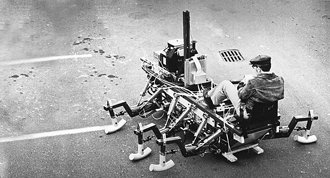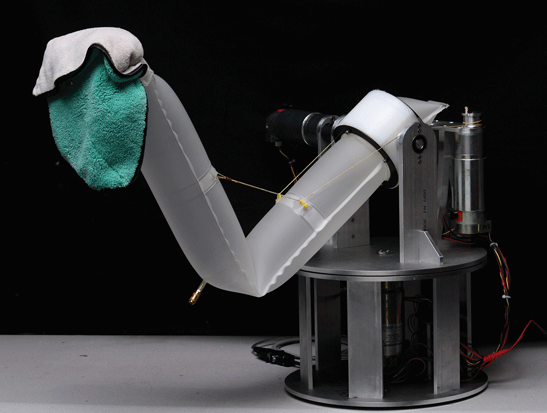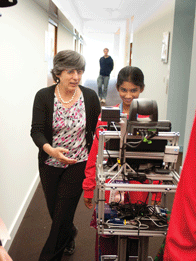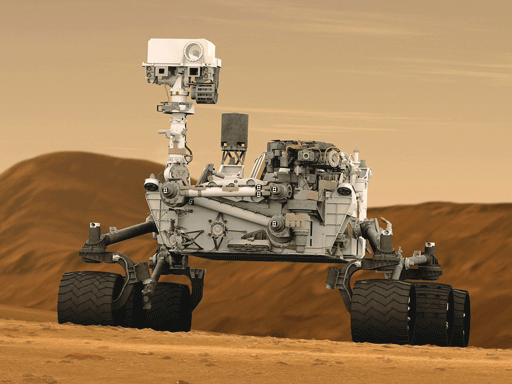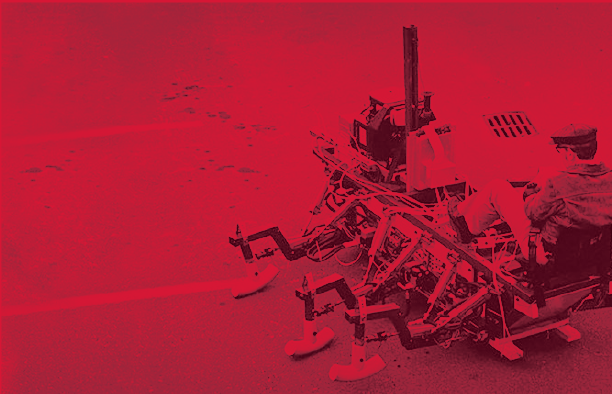
PRESERVING THE HISTORY OF ROBOTS
One Disassembled Part at a Time
Christina Rouvalis
In a nearly empty parking lot at Carnegie Mellon University, a strange hulking mechanical insect lurches forward, one spindly leg at a time. Stranger still, there’s a rider on top, telling it where to go.
It is December 12, 1982, and Ivan Sutherland (ENG 1959), esteemed computer scientist, is being filmed as he takes a test run on his Trojan Cockroach. He's not sure the ride will go exactly as planned. “Because,” as he says in the video, “it's the first time that I've driven the machine using the foot pedals, we may have a little excitement later on.”
But the hydraulic-powered bot follows his commands with precision, lumbering forward, backward and sideways. It even makes a 180- degree turn. Sutherland bounces a little on the seat, but the robot keeps its balance.
Though no crowd witnessed this profound moment — where one of the first walking robots carried a human — a videographer captured the scene. The grainy footage is being preserved as part of a new interactive, virtual exhibit called The Robotics Project. A collaboration between
University Libraries and the School of Computer Science, it will explore the legacy of robotics and Carnegie Mellon’s leadership role in a field that has shaped modern society.
The project will tell the story of robotics through a collection of early robots and disassembled bot parts, as well as photos, videos, notes, emails, drawings, code, interviews with some of the pioneers and even trading cards for kids and interested collectors. Believed to be the first of its kind in the world, The Robotics Project will tell the story of the Carnegie Mellon roboticists who pushed the boundaries of what autonomous machines could do for society, ideas that we take for granted today.
Even though Carnegie Mellon has led the field since its inception and has attracted top talent from around the world in establishing The Robotics Institute in 1979, University Archives has so far had a relatively sparse record of robotics history in its collection.
“We want to preserve robotics artifacts that are currently in attics, basements and closets, all around the campus and beyond — in people's homes and offices and warehouses,” said Katherine Barbera, lead archivist for The Robotics Project.
With many of the important robotics milestones stored on VHS tapes, compact discs and other obsolete formats that decay over time, the history and legacy could be lost forever, if not found and preserved.
Tracking down old robots for the exhibit can be challenging because the people who make them tend to be tinkerers who reuse materials, taking their bots apart to recycle the pieces into a new project. “There is a lot of cannibalizations,” Barbera said. “How do you tell the story of an artifact that no longer exists in its original form?”
BOW LEG HOPPER
A one-legged hopping robot that established the principle of dynamic balance
TROJAN COCKROACH
A six-legged robot that was the first capable of carrying a human
REMOTE RECONNAISSANCE VEHICLE
Surveyed and cleaned the flooded basement of the crippled Three Mile Island nuclear reactor
HIPNAV
The first computer-assisted surgery system
ROBODOG
CMU teams swept all divisions at the world championship RoboCup using RoboDog
For example, only a few isolated parts of Sutherland’s Trojan Cockroach remain. “It’s not even like we have a whole leg. We have parts of a leg,” Barbera said. Those fragments were saved after Sutherland’s son found them in the garage of his Squirrel Hill home and turned them over to Carnegie Mellon.
Building the Robot Archive, the first exhibit of The Robotics Project, is available online and gives a behind-the-scenes peek at how roboticists collaborated with archivists to preserve this history.https://exhibits.library.cmu.edu/roboticsproject .The Alfred P. Sloan Foundation provided funding for this first phase of the project.

“We want to preserve robotics artifacts that are currently in attics, basements and closets, all around the campus and beyond — in people’s homes and offices and warehouses.”
Looking Back to Move Forward
In mid-November 2021, The University Libraries opened a soft launch of Looking Back to Move Forward / A Re:collection of Robotics at Carnegie Mellon, located in the new first floor gallery of Hunt Library. Looking Back to Move Forward is the first physical exhibit offering a window into the ongoing work of The Robotics Project. It is scheduled to open officially in the Spring of 2022.
Through more than 40 robots and archival artifacts, the exhibition invites viewers to revisit material moments in the history of robotics and to explore a variety of research areas that CMU is known for —field robotics, artificial intelligence and human-robot interaction. With personal recollections from the people who made it all happen and a look inside the process of archiving robots, this exhibition engages the ongoing interplay between the past and the future in robotics research.
The curators are Katherine Barbera and Kathleen Donahoe, with art direction by Heidi Wiren Bartlett. The exhibition is located on the first floor of Hunt Library, in the recently renovated Emma Ochiltree Sharp Alcove.
Chris Atkeson, professor in the Robotics Institute, holding Baymax dolls from “Big Hero 6,” inspired by his soft bots
Barbera collaborates on the project with Chris Atkeson, a professor in the Robotics Institute, who has been collecting robot artifacts for years. Atkeson and his former graduate student, Daniel Pillus (CFA 2016), started collecting bot artifacts and formed a makeshift robot museum in the hallways of Newell-Simon Hall.
Atkeson noticed that the kids attending the university’s Cyert Center for Early Education were fascinated by the exhibit — especially the soft inflatable robots he created to help people dress, eat and comb their hair. Unlike the metal bots that could potentially hurt someone while helping them dress or fall over and injure a human, a soft robot can follow the movements of humans while helping them eat or dress. His soft bots became the inspiration for the character Baymax in the Disney movie “Big Hero 6.”
However in 2020, the fire marshal alerted the school that the robots and other memorabilia had to be removed from the hallway because they blocked a fire lane. Barbera helped Atkeson move the valuable artifacts to the library’s archives, and The Robotics Project was born.
“Faculty like Chris are invested in this history, not only because they were part of it, but because they see the potential for folks to want to interact with these materials in the future and learn from them,” Barbera said. “He had a lot of foresight in lovingly saving these artifacts.“
It takes a loving approach because some robot prototypes are extremely fragile. One juggling robot made by Atkeson was fashioned with duct tape.
“There’s a certain aura that exists around robotics for folks who are outside of the field,” Barbera said. “We tend to think of the finished product, and we don’t think of the processes behind it. So, they make the prototype with what is available — duct tape, string, pieces of wood.” These makeshift fasteners are easily and quickly torn down, reassembled and then discarded, making any images or films of them all the more historically valuable.
SOFTBOT
Soft, inflatable robots help people dress, eat and comb their hair
THE PERSONAL ROVER
A programmable robot that allowed a fun way to explore technologies necessary for scientific exploration
PEARL
A mobile robotic assistant for the elderly
BOSS
Led by Red Whittaker, Tartan Racing wins the 2007 DARPA Grand Challenge with BOSS
NAVLAB, an early pioneer in controlling a car by computer
The videos and photos of the project also tell the stories of important pioneers such as Sutherland, a Carnegie Tech graduate who returned to campus decades later. “He is better known as the father of computer graphics,” Barbera said. “A lot of people were surprised to hear of his long-standing interest in robotics as well.” In the ‘80s, he partnered with Carnegie Mellon to develop what became the Trojan Cockroach.
Another major aspect of the project catalogs the rich history of autonomous vehicles at CMU. In 1986, a Carnegie Mellon team created the Navigation Laboratory (Navlab 1), an electric-blue Chevy van that was one of the first cars to be controlled by a computer. A video of the NavLab 1 cruising along at 2 miles per hour is a feature of the online archive. The archive also contains a photo of the team standing in front of that vehicle and also a trading card of Navlab 7, a 1996 white Pontiac Bonneville. The legacy of NavLab and its pioneering role in the field of computer vision for the field of self-driving cars, is on display.
However, many more innovations and emergent fields within robotics require preservation. In 1982, Haruhiko Asada, then a visiting research professor in the Robotics Institute, and his colleagues there developed the first direct-drive robotic arm — an arm with articulated joints directly coupled to high-performance torque motors. Because the arms did not have any gears, they were not stiff, making them more compliant during human-robot interactions. For example, a direct-drive arm on a personal care robot would be able to help someone dress with less

“Intelligence is asking for help. That is what it’s all about. You figure out a few things, and you ask for help.”
Manuela Veloso, professor emerita in SCS explains CoBot with a student.
To add context to the robotic artifacts, the archivists are adding video oral history interviews with some of the pioneers. In one video clip, Manuela Veloso, professor emerita in the School of Computer Science, discusses her pioneering work on Symbiotic Autonomy with CoBots, which is short for collaborative robots that do multiple tasks in an uncertain environment. In a video interview as part of the project,
Veloso discusses how she came up with the idea of a CoBot asking humans for help, such as pressing the button on an elevator.
Some of her colleagues initially thought the idea was heresy. She recalls them saying, “Oh my God, she is cheating. What do you mean —ask for help?” Robots, after all, are supposed to be autonomous. But in the interview, Veloso said, “Intelligence is asking for help. That is what it’s all about. You figure out a few things, and you ask for help.”
The Robotics Project, which began online but now has its first physical exhibit in the first-floor gallery of Hunt Library, intends to be a place that would appeal as much to a layperson or student as it would to scientists and computer historians.
Robots have long fascinated sci-fi fans, but with their prevalence in everyday life — self-driving cars, meal delivery robots in hospitals, and assistive technology for people with disabilities — interest in the field has never been higher. “There is a sense that you are bringing something to life,” Atkeson said. “You don’t just want a robot locked in a museum case. But when it begins to move, it feels alive. That is very appealing.”
MOON LANDER
A robot capable of landing a payload rover onto the lunar surface, using sensors, rockets and mapping software for precision landings
HERB
Short for Home Exploring Robot Butler, a bi-manual mobile manipulation platform
CHIMP
A four-limbed robot created to respond to disasters competed at the 2015 DARPA Robotics Challenge
PROFILER 2
A rugged, mobile robot that enabled safe and remote mapping in underground mines
PERSEVERANCE
Operated remotely on Mars, this Rover seeks signs of ancient life and collects samples of rock and soil for possible return to Earth



